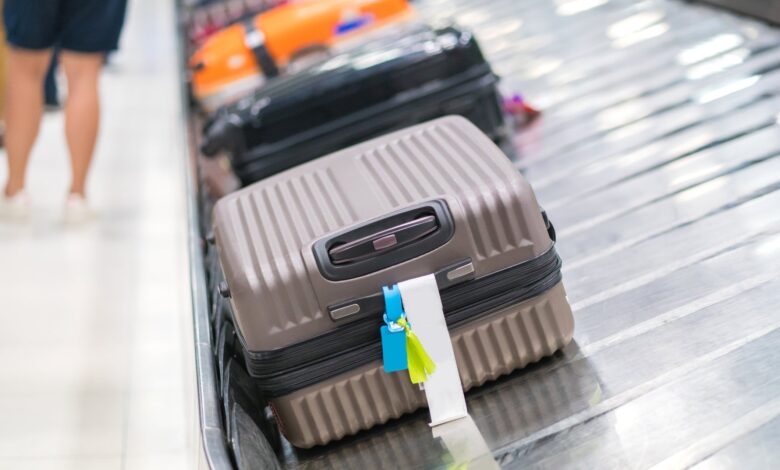What to do if an airline damages your luggage

If you’ve ever grabbed your luggage off the baggage carousel at an airport and found it looking a little worse for wear, you’re not the first.
According to a report by SITA — a leading specialist in air transport communications and information technology — airlines around the world “damaged or pilfered” 13% of the 26 million bags reported as “mishandled” in 2022. (The term “mishandled” includes bags that were delayed, lost or stolen, too.)
When your luggage leaves your sight at the airport check-in desk to start its journey to your destination, it might pass along various conveyor belts, catch a ride on some type of vehicle or trolley and go through a myriad of baggage handlers on its way to getting slid, tossed and pushed into the airplane’s cargo hold.
It’s a journey of its own, in other words. So, getting your bag returned with a few scrapes and scratches along the way is not uncommon. But what happens when your bag has more than few minor bumps and bruises? Here’s what you should do next.
Before leaving the airport, check your bag for damage
First of all, be aware of the condition your bag was in when you checked it. Take photos of the bag’s exterior and of the contents inside. It’ll be easier to file a claim if you can prove your bag was in good condition when you dropped it off.
When you grab your bag off the carousel or planeside, take note of any damage that wasn’t there previously.
If there’s something more than the normal wear and tear from ordinary handling, photograph the damage to your luggage and its contents. You may need it later to substantiate any claims.
Take a photo of the baggage tags, too, and be sure to leave them on your bag until you’ve submitted your claim.
Related: Why I’ll take photos and videos of my suitcase contents before my next trip

Daily Newsletter
Reward your inbox with the TPG Daily newsletter
Join over 700,000 readers for breaking news, in-depth guides and exclusive deals from TPG’s experts
File a claim
It’s easiest and best to report any damage to your bag before you leave the airport.
You can make your claim at the baggage service office for the airline you flew with; it’s usually right by the luggage carousel (and it’s the same place you’d go to report a missing bag that didn’t show up on the belt).
If the baggage service office is closed, head to the airline’s check-in counter to ask who should be contacted in the event of damaged luggage.
Of course, how things are handled will depend very much on the airline and the damage done. But whatever you do, hold on to your damaged bag until you’ve settled your claim. The airline may pay for you to ship it to be repaired, or you may need it for other proof to substantiate a claim.
Related: Steps to take if you think an airline has damaged your luggage
Know your rights
For domestic flights, a regulation from the U.S. Department of Transportation allows airlines to limit their liability for a lost, damaged or delayed bag to $3,800 per passenger. That amount is the most you could potentially receive for your luggage. Airlines are free to pay more than the limit but are not required to do so.
The maximum baggage liability for most international flights is set by a treaty called the Montreal Convention. That amount is currently approximately $1,700 per passenger, and it is reviewed for inflationary adjustment every five years. This is the most that airlines must pay a passenger for a lost, damaged or delayed bag. Again, airlines can pay more than the limit, but it is not a requirement.
Airlines themselves also have a Contract of Carriage that you can usually find on their website, as in this example for American Airlines. It details the maximum amount the airline will pay if liable for a lost, damaged or delayed bag.
Related: What to do when your luggage is delayed or lost by an airline
What if you don’t notice damage until after you’ve left the airport?
In that case, it might not even be bad enough to warrant a claim.
If the damage to your bag isn’t so bad that you need a new one to transport its contents and you’re flying the same airline on your return flight, report it at the airport when you land after your return trip.
If you’re not flying back with the same airline and have already left the airport, the only thing left to do is to call the airline you flew with to report the damage and see what steps they suggest next for filing a claim. (This is when those photos you took when you landed will come in handy.) Some airlines also offer online forms for making claims about damaged luggage.
Keep in mind that airlines have varying windows of time after a flight during which it’s considered valid for reporting luggage damage.
American, Delta Air Lines and United Airlines, for example, require you report your claim within 24 hours of your flight for domestic flights and within seven days for international flights.
Southwest Airlines is far stricter for domestic flights: It gives travelers just four hours from landing to make a claim about damaged luggage. For international flights, a traveler must contact Southwest within seven days.
Airlines often require that baggage tags remain attached to your luggage. So, a backup photo of them can come in handy if you’ve already torn them off.
Just keep in mind that in the end, it’s the airline that decides what compensation, if any, you’ll get for a damaged bag. Everything is considered on a case-by-case basis.
Normal wear and tear from things like overpacking and manufacturer defects are not likely to be covered. In that case, you can always try going to your bag’s manufacturer directly with your claim or see if the credit card you used to purchase your flight includes baggage insurance.
Related: How luggage protection saved me $1,100 — reader success story
Other considerations
It’s up to you to assess if the damage to your bag warrants devoting your time and energy to filing a claim at the luggage service office before you leave the airport.
A small scrape along the side of your hard case bag? Not so much. Missing wheels, a broken handle and a slash in the side of your soft suitcase? Now you’re talking.
Another thing to consider is whether the airline will accept your damaged bag to be checked in on a return flight. If your bag is too damaged to be checked in again, that’s reason enough to file a claim.
When it comes to buying luggage, consider the rough journey it takes on its travels. Don’t purchase luggage that’s too dainty to hold up to the task (especially if it’s expensive and you live in fear of its getting damaged).
Consider, too, potential damage to the contents of your bag; never check a bag that has anything essential or valuable inside.
Related: Here’s what to pack in a carry-on bag every time you travel
Bottom line
The more you travel and check a bag, the more likely it is you may experience damaged luggage at some point.
As with all things in life, a calm and collected approach is sure to work better than frustration and anger. Taking out your anger on an airline employee will not get your claim resolved any faster.
Related reading:




